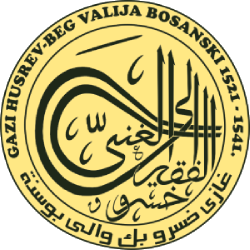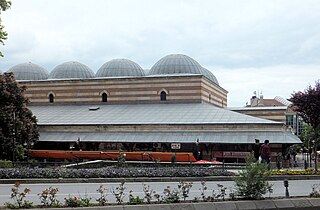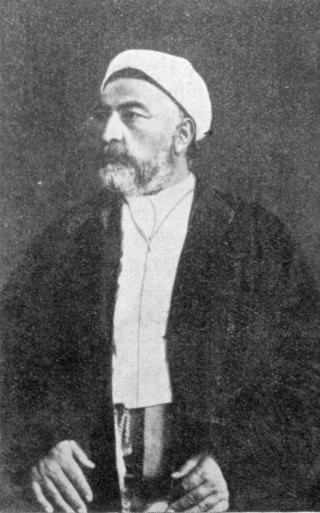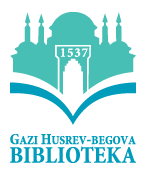
Sarajevo is the capital and largest city of Bosnia and Herzegovina, with a population of 275,524 in its administrative limits. The Sarajevo metropolitan area including Sarajevo Canton, East Sarajevo and nearby municipalities is home to 555,210 inhabitants. Located within the greater Sarajevo valley of Bosnia, it is surrounded by the Dinaric Alps and situated along the Miljacka River in the heart of the Balkans, a region of Southeastern Europe.
Sarajevo is a city now in Bosnia and Herzegovina.

Stari Grad is a municipality of the city of Sarajevo, Bosnia and Herzegovina. It is the oldest and most historically significant part of Sarajevo. At its heart is the Baščaršija, the old town market sector where the city was founded by Ottoman general Isa-Beg Ishaković in the 15th century.

Sultanzade Gazi Husrev-beg was an Ottoman Bosnian sanjak-bey (governor) of the Sanjak of Bosnia in 1521–1525, 1526–1534, and 1536–1541. He was known for his successful conquests and campaigns to further Ottoman expansion into Croatia and Hungary. However, his most important legacy was major contribution to the improvement of the structural development of Sarajevo and its urban area. He ordered and financed construction of many important buildings there, and with his will bequeathed all his wealth into endowment for the construction and long-term support of religious and educational facilities and institutions, such as the Gazi Husrev-beg Mosque, and the Gazi Husrev-begova Medresa complex with a Gazi Husrev-beg Library, also known as Kuršumlija.

Gazi Husrev-beg Mosque is a mosque in the city of Sarajevo, Bosnia and Herzegovina. Built in the 16th century, it is the largest historical mosque in Bosnia and Herzegovina and one of the most representative Ottoman structures in the Balkans. Having been Sarajevo's central mosque since the days of its construction, today it also serves as the main congregational mosque of the Muslims in Bosnia and Herzegovina. It is located in the Baščaršija neighborhood in the Stari Grad municipality and, being one of the main architectural monuments in the town, is regularly visited by tourists.

A bedesten is a type of covered market or market hall which was historically found in the cities of the Ottoman Empire. It was typically the central building of the commercial district of an Ottoman town or city, where the most important and precious goods were kept and sold. Its function was comparable or equivalent to that of a qaysariyya in other regions, though the architecture of the latter could be different and be similar to that of a bazaar with its own streets.

Türbe refers to a Muslim mausoleum, tomb or grave often in the Turkish-speaking areas and for the mausolea of Ottoman sultans, nobles and notables. A typical türbe is located in the grounds of a mosque or complex, often endowed by the deceased. However, some are more closely integrated into surrounding buildings.

Baščaršija is Sarajevo's old bazaar and the historical and cultural center of the city. Baščaršija was built in the 15th century when Isa-Beg Ishaković founded the city.

Dr. Safvet-beg Bašagić, also known as Mirza Safvet, was a Bosnian writer who is often described by Bosniak historians as the "father of Bosnian Renaissance", and one of the most renowned poets of Bosnia and Herzegovina at the turn of the 20th century. Bašagić co-founded the political journal Behar and was a founder of the cultural society and magazine Gajret, and was elected President of the Bosnian council in 1910. He is also well known for his oeuvre which exceeds seven hundred biographies he compiled over decades.
The following is a timeline of the history of the city of Sarajevo, Bosnia and Herzegovina.

Mustafa-beg Fadilpašić was the first Mayor of Sarajevo, Bosnia and Herzegovina. He was appointed mayor in 1878 after more than 14,000 Austro-Hungarian troops, led by Josip Filipović, captured Bosnia and Herzegovina from the declining Ottoman Empire. He remained the mayor for the last 14 years of his life.

The Gazi-Husrev-beg Library is a public library in Sarajevo, Bosnia and Herzegovina founded in 1537 by the sanjakbey of Bosnia Gazi Husrev-beg during Ottoman rule, it is a part of the larger complex with the Gazi Husrev-beg Medresa. It holds one of the most important collections of Islamic manuscripts in Bosnia-Herzegovina, including many originally donated by Gazi Husrev-beg. The collection survived through Bosnian war and Siege of Sarajevo. The library also holds a sizable number of books, journals, newspapers, documents and photographs.
Hüsrev is a Turkish given name derived from the Persian name "Khusraw", having the same meaning.

The Sarajevo Clock Tower is a clock tower in Sarajevo, the capital of Bosnia and Herzegovina. It is located beside Gazi Husrev-beg Mosque and is the tallest of the 21 clock towers erected throughout the country, reaching a height of 30 meters. The tower was declared a National Monument of Bosnia and Herzegovina in 2006.

The Aladža Mosque, also known as Šarena džamija, "Colorful Mosque", is an Ottoman era mosque that was built in 1549 and located in Foča, Bosnia and Herzegovina. It is considered one of the most beautiful and important examples of Ottoman architecture in Europe, and is one of the most important Ottoman era mosques in all of Bosnia and Herzegovina; along with the Gazi Husrev-beg Mosque in Sarajevo and the Ferhadija Mosque in Banja Luka. It was completely destroyed with pre-planted explovises at the beginning of the Bosnian War in 1992 by the VRS, and levelled to the ground; along with the left over stones and rubble from the mosque being hidden all over Foča to prevent its reconstruction. After many years of searching for the stones once the Bosniak refugees of Foča began to return, and sourcing the funds necessary for the reconstruction of the mosque, its reconstruction was started in 2016, and completed in 2018.

Sarači street is one of main pedestrian streets in Sarajevo, located in Baščaršija, Stari Grad Municipality. Sarači street is named after Saraç, a Turkish word for craftsmen who are making saddles.

JU Gazi Husrev-begova medresa, Sarajevo is a high school and college, a madrasa in Arabic, founded on 8 January 1537 CE and built in Sarajevo as Gazi Husrev-beg's second endowment. It was built in the style of the Istanbul madrasas, and was called Kuršumlija because it was covered with a lead roof.

Gazi Husrev-beg's bezistan is one of the preserved bezistan in Sarajevo, Bosnia and Herzegovina, from the Ottoman period in the history of the country. Built in 1555 in Baščaršija, bezistan still serves its purpose - trade.

Gazi Husrev-beg's Hanikah is a hanikah in Sarajevo. Tesavuf was studied in hanikah, and today it has an artistic purpose.

Tašlihan or Tašli han is a former caravanserai that was located on the site of the current summer garden and an open bar of the Hotel Evropa in Sarajevo, Bosnia and Herzegovina. It is the third stone caravanserai in Sarajevo, built in the period from 1540 to 1543, as an endowment of Gazi Husrev-beg, after his death. It was added to Gazi Husrev-beg's bezistan on its western side. It was square in shape, and its length was 47 meters. It had a fountain in its yard, on the pillars of which was a small mosque. Upstairs were the passenger rooms. Domestic and foreign merchants had their shops within Tašlihan. It is believed that this caravanserai served for trade more than for passenger traffic. The fire of 1879 severely damaged Taslihan and made it unusable.





















